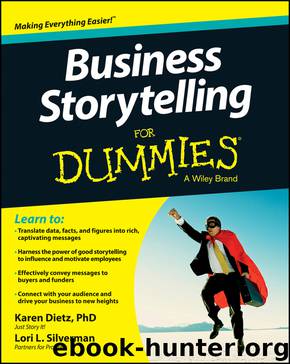Business Storytelling For Dummies by Karen Dietz PhD & Lori L. Silverman

Author:Karen Dietz, PhD & Lori L. Silverman
Language: eng
Format: epub
Publisher: John Wiley and Sons, Inc.
Published: 2013-11-20T16:00:00+00:00
Chapter 11
Moving Stories into Multiple Media
In This Chapter
Knowing the various media available to transmit stories
Identifying the pluses and minuses of each medium
Figuring out which medium is best to use
A large organization asked a colleague of ours to bid on a digital storytelling project. It was obvious that the client had focused on the technology — not on the story itself. They didn’t have a clue about what story needed to be told and why, its key message and purpose, the audience for it, or how to craft it before deciding which medium to use. Our colleague covered these missing items in the proposal. A few weeks later she got a call saying she’d won the contract. She was the only one of six bidders who talked about the strategy for the story and its crafting. The rest had focused solely on the technology.
Sadly, this situation isn’t unusual. Overall, we find a significant lack of understanding about what’s gained or lost when moving stories into different medium. Assuming you’ve crafted a wonderfully compelling story based on the previous chapters, there’s a continuum of media (also called communication channels) you can use to share it. Each medium is suited to different purposes. This six-channel continuum, ranked by distance to the storyteller, assumes that the closer you are to the teller, the more powerful the experience. For example, because the graphic capture of stories is visual, many elements of oral, digital, and written stories are missing from them. We explain more as we go along in this chapter. Here’s the continuum:
Oral: One-on-one or group setting in person (most effective).
Digital: Video, film, slides or SlideShare, and so on. Although we realize almost anything can be digitized, digital storytelling specifically refers to the media listed here. Remember this as you read the chapter.
Audio: Radio or recordings delivered online, via MP3, or on CD.
Written: Blogs, newsletters, e-mails, websites, and so on.
Graphic: Photo novellas and comics as well as posters, infographics, photomontages, and collages.
Icons: Tangible objects (least effective in certain situations).
The medium (or media) you choose has an impact on connection, audience experience, repeatability, and other critical factors — all covered here.
Criteria for Deciding on Media
We use eight criteria for deciding which media to use for sharing a story. You can use them on your organization’s stories and your own. We comment on each one as we take you through the six communication channels:
1. Audience experience: How engaged or passive will the audience be when consuming the story?
2. Availability of connection: The kind of link the story will have — will it be to you, the company, a piece of technology? We also look at the quality of this link and how long it takes the bond to occur — is it immediate or delayed?
3. Richness of channel: How much and how dense does the sensory data, language of the senses (LOTS), and body language need to be?
4. Flexibility of the medium: How malleable is the media for changing and adapting the story over time?
5.
Download
This site does not store any files on its server. We only index and link to content provided by other sites. Please contact the content providers to delete copyright contents if any and email us, we'll remove relevant links or contents immediately.
Cecilia; Or, Memoirs of an Heiress — Volume 1 by Fanny Burney(31333)
Cecilia; Or, Memoirs of an Heiress — Volume 3 by Fanny Burney(30934)
Cecilia; Or, Memoirs of an Heiress — Volume 2 by Fanny Burney(30889)
The Lost Art of Listening by Michael P. Nichols(6474)
We Need to Talk by Celeste Headlee(4870)
Asking the Right Questions: A Guide to Critical Thinking by M. Neil Browne & Stuart M. Keeley(4576)
On Writing A Memoir of the Craft by Stephen King(4214)
Dialogue by Robert McKee(3582)
I Have Something to Say: Mastering the Art of Public Speaking in an Age of Disconnection by John Bowe(3516)
Pre-Suasion: A Revolutionary Way to Influence and Persuade by Robert Cialdini(3414)
Elements of Style 2017 by Richard De A'Morelli(2945)
The Book of Human Emotions by Tiffany Watt Smith(2772)
Good Humor, Bad Taste: A Sociology of the Joke by Kuipers Giselinde(2557)
Name Book, The: Over 10,000 Names--Their Meanings, Origins, and Spiritual Significance by Astoria Dorothy(2491)
Fluent Forever: How to Learn Any Language Fast and Never Forget It by Gabriel Wyner(2446)
The Grammaring Guide to English Grammar with Exercises by Péter Simon(2394)
Why I Write by George Orwell(2359)
The Art Of Deception by Kevin Mitnick(2298)
Don't Sleep, There Are Snakes by Daniel L. Everett(2217)
